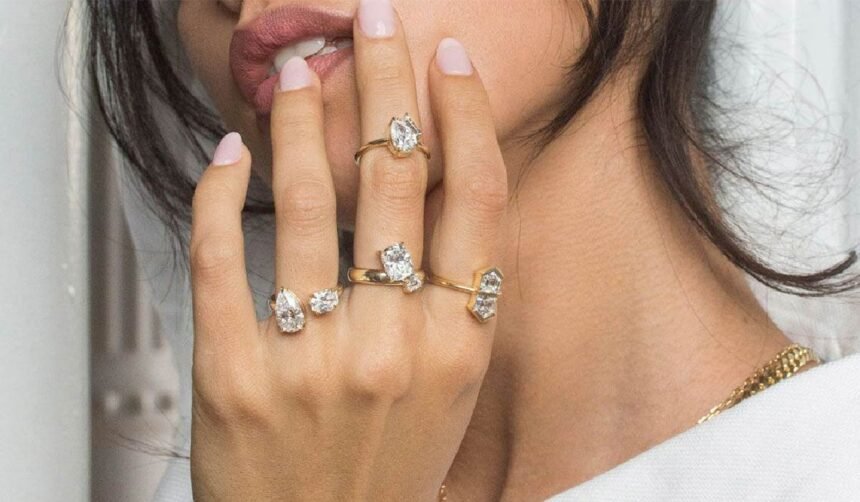Engagement ring shopping looks different from what we saw five years ago. Jewelers are reporting increased requests for cuts that were popular decades ago but fell out of fashion. The marquise cut, which dominated the 1980s before nearly disappearing, has returned with modified proportions that reduce the sharp points while maintaining the elongated shape. Cushion cuts with chunky facets rather than crushed ice patterns are appearing in boutique collections across major cities.
These vintage-inspired cuts work particularly well when paired with contemporary band designs. A marquise stone set east-west on a thin band creates a horizontal line that sits lower on the finger, making it practical for people who work with their hands. Meanwhile, old mine cuts are being recut with slightly different angles to improve light performance while keeping their antique character.
Stone Shapes Making Their Mark in 2026
Fashion weeks in Paris and Milan have started influencing engagement ring choices in unexpected ways. Designers are drawing from architectural movements of the 1970s, bringing back elongated silhouettes that complement modern minimalist settings. The pear shaped engagement ring has become a favorite among couples who want something between traditional round cuts and edgier marquise stones, while emerald cuts appeal to those drawn to Art Deco influences.
Color combinations are changing too. Rose gold bands with champagne diamonds, platinum settings with salt-and-pepper stones, and mixed metal designs that combine yellow and white gold are replacing the standard solitaire approach. These combinations work particularly well with asymmetrical cuts that catch light from different angles.
Lab Stones Meet Natural Inclusions
The conversation around lab-grown versus natural diamonds has taken an interesting turn. Rather than treating these as competing options, many couples now choose both in the same ring. A natural center stone with lab-grown accent stones has become common, though some prefer the reverse arrangement for budget reasons. What’s surprising is the growing interest in stones with visible inclusions, which would have been rejected ten years ago.
Salt-and-pepper diamonds, once considered unsuitable for engagement rings, now command premium prices when the inclusion patterns create interesting visual effects. Black diamonds with natural fractures that create web-like patterns inside the stone are particularly sought after. These imperfect stones pair well with rough-textured bands that show tool marks or deliberate surface irregularities.
Settings That Break Convention
The traditional prong setting remains popular, but jewelers are experimenting with alternatives that change how stones interact with light. Tension settings, where the stone appears to float between two ends of the band, work especially well with harder stones like sapphires and rubies. Bezel settings that cover only three-quarters of the stone’s circumference allow more light to enter while still providing security.
Some designers have started incorporating negative space into their settings. Rather than surrounding stones with metal, they create frameworks that hold stones at specific points while leaving large sections exposed. This approach requires precise engineering but produces rings that look different from every angle. The technique works best with stones that have excellent clarity since there’s nowhere for imperfections to hide.
Colored Stones Take Center Stage
While diamonds remain the most common choice, colored gemstones are gaining ground in ways that would have seemed unlikely a decade ago. Padparadscha sapphires, with their distinctive peachy-pink color, have become particularly desirable among collectors who appreciate their rarity. These stones often cost more than comparable diamonds, which has changed the perception that alternative stones are budget options.
Montana sapphires offer another interesting option. These stones come in colors ranging from teal to yellow-green, with many showing color-change properties under different lighting. Unlike traditional blue sapphires, Montana stones often display multiple colors simultaneously, creating depth that changes throughout the day. Jewelers report that customers specifically request these stones after seeing them in person, as photographs rarely capture their complexity.
Metal Combinations and Textures
The idea that engagement rings should use a single metal has largely disappeared. Rings now feature two, three, or even four different metals in various combinations. A yellow gold band might transition to white gold near the stone, or rose gold accents might appear as subtle details on an otherwise platinum ring. These combinations require careful planning to ensure the metals wear evenly over time.
Surface treatments have become equally important. Hammered finishes that create tiny facets across the band surface produce subtle sparkle without adding stones. Sand-blasted finishes create matte surfaces that contrast with polished stone settings. Some jewelers use chemical etching to create patterns that would be impossible to achieve through traditional metalworking techniques. These textures often improve with wear, developing patinas that make each ring unique to its wearer.
The engagement ring market in 2026 shows that personal preference has overtaken traditional rules about what makes an appropriate engagement ring. Couples choose designs based on their lifestyles, aesthetic preferences, and budget considerations rather than following prescribed formulas. This freedom has led to more interesting designs and happier customers who feel their rings genuinely represent their relationships.









